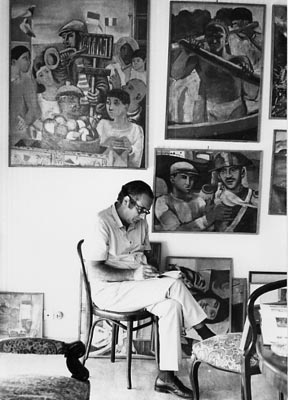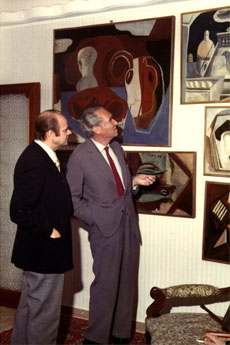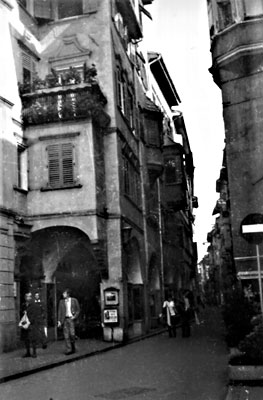(dma)
-
The fact that Hess' paintings only saw the light of day again thirty
years after the end of the war clearly shows how difficult their
recovery was. The restoration proposed by Lionel Fioravanti Massa
was successfully carried out by Prof. Everardo Pavia at his workshop
in via Margutta in Rome. The restored paintings were then returned
to Messina and put on display as if in a gallery on the walls of
Emma's sun-filled apartment.
Finally the recovery was completed and the extraordinary gallery
could be exhibited to art critics, journalists and representatives
of institutions and cultural organisations so they could appreciate
at first hand the importance of the Rediscovery.
|
 |
|
The critic Marcello
Venturoli during his visit to see Hess' paintings in
Messina in the summer of 1972 |
|
 |
Messina - Summer 1972 - Domenico M.
Ardizzone (left) with the German art critic Hans
Eckstein who is examining Hess' paintings which were
restored in preparation for the travelling
exhibition of the Rediscovery.
|
The first to examine the paintings were the art critics Marcello
Venturoli (Rome) and Hans Heckstein (Munich) who were to write essays
included in the catalogue produced for the 1974 travelling exhibition
dedicated to the Rediscovery. Venturoli had known nothing about Hess but
immediately became passionately interested in the artist's life and
work. He studied the paintings, water-colours and drawings seeking a
deeper understanding of Hess' techniques, style, themes and meanings.
Hans Eckstein already knew Hess' work after reviewing several of the
artist's exhibitions in Munich during the 1930's. Seeing again
some paintings which he had last seen displayed at the Munich Glaspalast
was a great surprise for the German critic. Not least because the last
time he had seen any of Hess' paintings was in an exhibition of works
destined for export in Munich in 1948, four years after the death of the
artist. (At the time, however, Eckstein did not know that Hess had died
following an air raid on Innsbruck.)
Among the series of visits which followed to Emma's home the most
significant was that by a group of German journalists accompanied by the
German Consul to Messina Friedrich Löbau. The visit was given wide
coverage in the Bavarian press and on the radio. Meanwhile in Rome, the
project for the Rediscovery of Hess' work was presented at the German
Academy at Villa Massimo, the Austrian Cultural Institute, the Goethe
Institut, the Swiss Institute and the Galleria Giulia whose director,
Ennio Casciaro, was also head of the Galleria Goethe in Bolzano, which
was due to host a stage of the travelling exhibition.
|
 |
|
Bolzano - The Colonnade (Laubengasse)
The house where L. Christian Hess was born. |
At the same time contact was also being made with
leading art critics in Sicily, Messina University and with regional
institutions in Palermo where there was also a local centre of the
Goethe Institute. My
diary for 1972
was full of appointments linked to the project. We quickly received
positive responses from the Goethe Institute and the Sicilian Regional
Council as well as official support for the travelling exhibition from
the European Parliament. In 1972 as luck would have it I was a delegate
to the National Union of Journalists' conference held that year in
Bolzano. During my stay in the city I sought out Hess' birthplace and
made contact with local authorities. These meetings helped bring Hess
back to Bolzano and his Tyrolean homeland in general. They led to the
exhibition at the Galleria Goethe as well as the placing of a
commemorative plaque in the central colonade in Laubengasse. Once the
union conference was over I travelled to Innsbruck to meet the director
of the Italian Cultural Institute Prof. Aldo Lucciarini, the chairman of
the Artists' Union Paul Flora and the painter Wilfried Kirschl. All
three were to contribute to the success of the exhibition which a few
years later was held in the prestigious rooms of the Tiroler
Landesmuseum "Ferdinandeum".
Paul Flora, Wilfried Kirschl and Aldo Lucciarini paid
homage at the graveside of
Christian Hess on 26 November 1974, the 30th anniversary of the artist's
death. The same day in Palermo saw the inauguration of the exhibition
celebrating the Rediscovery of his work.
|